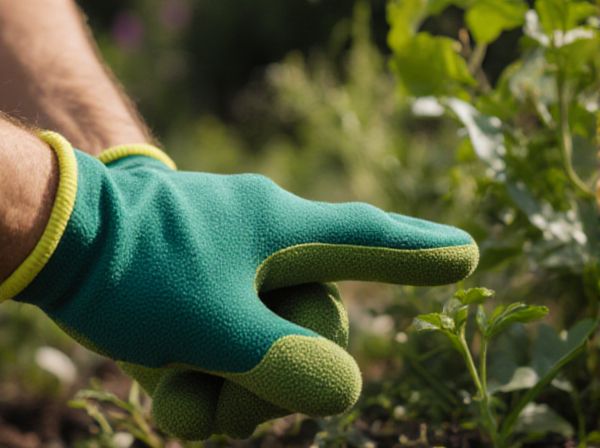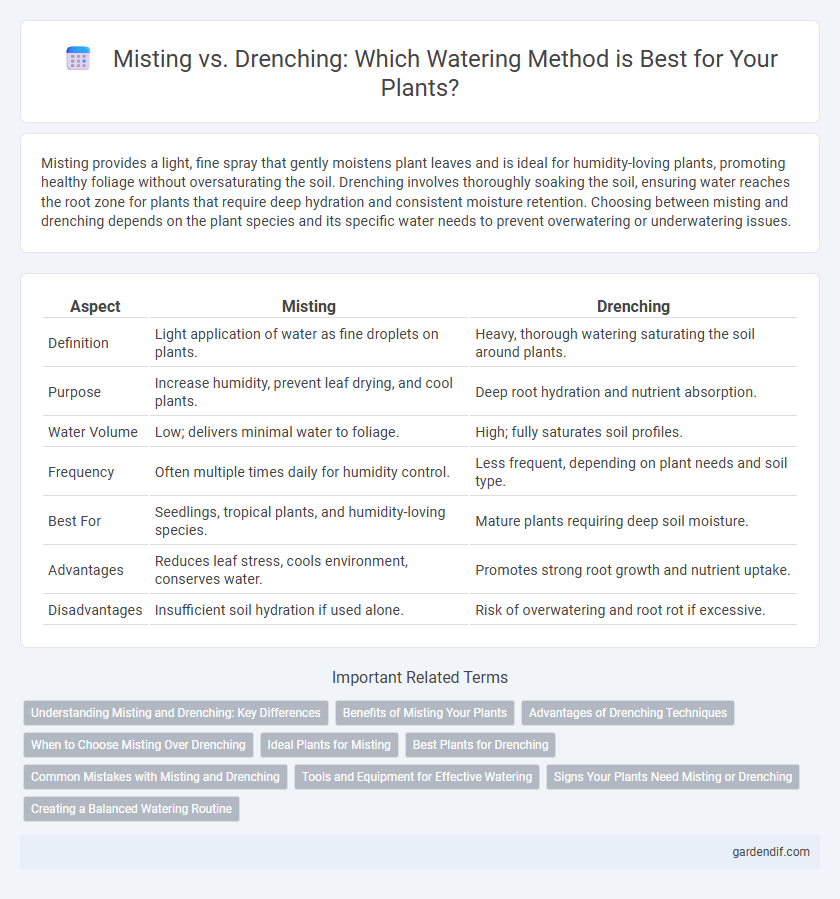
Misting vs Drenching Illustration
Misting provides a light, fine spray that gently moistens plant leaves and is ideal for humidity-loving plants, promoting healthy foliage without oversaturating the soil. Drenching involves thoroughly soaking the soil, ensuring water reaches the root zone for plants that require deep hydration and consistent moisture retention. Choosing between misting and drenching depends on the plant species and its specific water needs to prevent overwatering or underwatering issues.
Table of Comparison
| Aspect | Misting | Drenching |
|---|---|---|
| Definition | Light application of water as fine droplets on plants. | Heavy, thorough watering saturating the soil around plants. |
| Purpose | Increase humidity, prevent leaf drying, and cool plants. | Deep root hydration and nutrient absorption. |
| Water Volume | Low; delivers minimal water to foliage. | High; fully saturates soil profiles. |
| Frequency | Often multiple times daily for humidity control. | Less frequent, depending on plant needs and soil type. |
| Best For | Seedlings, tropical plants, and humidity-loving species. | Mature plants requiring deep soil moisture. |
| Advantages | Reduces leaf stress, cools environment, conserves water. | Promotes strong root growth and nutrient uptake. |
| Disadvantages | Insufficient soil hydration if used alone. | Risk of overwatering and root rot if excessive. |
Understanding Misting and Drenching: Key Differences
Misting delivers a fine, gentle spray of water that helps maintain humidity and lightly moistens plant surfaces without saturating the soil. Drenching involves applying a large volume of water directly to the soil, thoroughly saturating the root zone to promote deep absorption and prevent dehydration. Understanding these key differences allows gardeners to optimize watering techniques based on plant needs and environmental conditions.
Benefits of Misting Your Plants
Misting your plants provides essential humidity, which is crucial for tropical and moisture-loving species, enhancing their overall health and growth. This gentle method minimizes overwatering risks by delivering moisture directly to the foliage without saturating the soil, reducing root rot and fungal issues. Frequent misting also aids in dust removal from leaves, improving photosynthesis efficiency and plant vitality.
Advantages of Drenching Techniques
Drenching provides deep soil saturation, promoting extensive root growth and enhancing plant resilience during dry periods. This technique efficiently delivers nutrients and pesticides directly to the root zone, improving uptake and plant health. Compared to misting, drenching reduces water waste by minimizing evaporation and runoff, making it ideal for water conservation.
When to Choose Misting Over Drenching
Misting is ideal for delicate plants, seedlings, or those prone to overwatering, as it provides gentle moisture without saturating the soil. Choose misting when humidity needs to be increased or when watering foliage to prevent fungal diseases and leaf damage. This method is also effective in maintaining moisture for epiphytes and orchids that absorb water primarily through their leaves.
Ideal Plants for Misting
Misting is ideal for tropical plants such as ferns, orchids, and bromeliads, which thrive in high humidity environments. These plants benefit from the fine water droplets that increase ambient moisture without saturating the soil. Unlike drenching, misting reduces the risk of root rot while supporting leaf health and photosynthesis efficiency.
Best Plants for Drenching
Drenching provides deep soil moisture ideal for plants with extensive root systems such as vegetables, shrubs, and large-perennial flowers. Succulents and delicate seedlings are less suited for drenching because excess water can cause root rot or damage. Heavy feeders like tomatoes, peppers, and hydrangeas thrive under drenching as it delivers nutrient-rich water directly to the root zone.
Common Mistakes with Misting and Drenching
Overwatering through drenching can cause root rot by saturating the soil and preventing oxygen absorption, while inconsistent misting often fails to adequately hydrate plants, leading to dehydration stress. Common mistakes include misting outdoor plants exposed to direct sunlight, which can cause leaf burn, and drenching potted plants without proper drainage, resulting in waterlogged roots. Optimizing watering frequency and technique based on plant type and environmental conditions is essential to prevent these issues and promote healthy growth.
Tools and Equipment for Effective Watering
Misting utilizes fine nozzles or spray bottles that distribute water evenly in tiny droplets, ideal for delicate plants and seedlings. Drenching requires hoses or watering cans with larger spouts to deliver a thorough soak, ensuring deep soil penetration for mature plants. Choosing between misting and drenching tools depends on plant type, soil conditions, and watering goals, optimizing moisture absorption and plant health.
Signs Your Plants Need Misting or Drenching
Wilting leaves and dry soil surface indicate your plants need drenching to deeply rehydrate the root zone, promoting healthy growth. Pale or brown leaf edges and a dusty leaf surface signal the need for misting to increase humidity and reduce plant stress, especially for tropical species. Monitoring these signs helps optimize watering methods, preventing overwatering and maintaining plant health.
Creating a Balanced Watering Routine
Misting provides a fine layer of moisture ideal for humidity-loving plants, while drenching ensures deep soil saturation essential for root health. Combining both techniques creates a balanced watering routine that supports plant hydration without overwatering. Adjust frequency based on plant species, environmental conditions, and soil type for optimal growth and prevention of root diseases.
Misting vs Drenching Infographic

 gardendif.com
gardendif.com